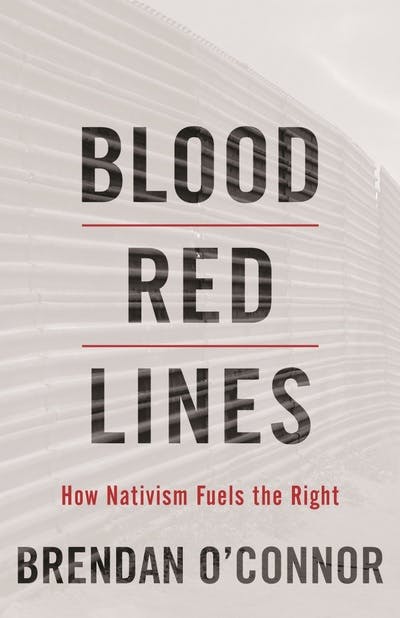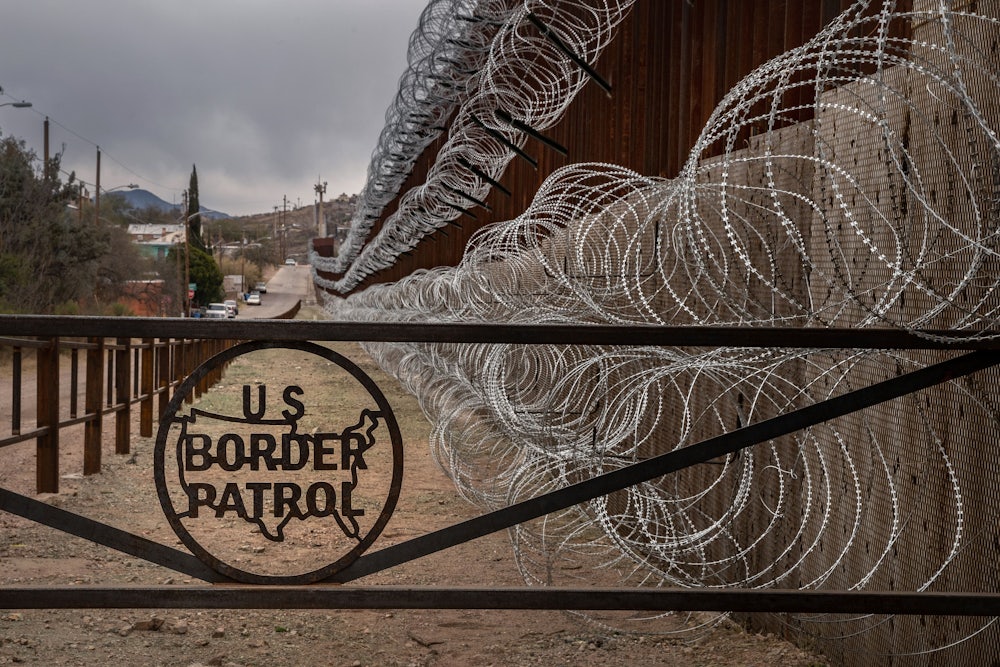In early December, conservative commentators tried to drum up social media controversy over a sweatshirt. The shirt, merchandise for Alexandria Ocasio-Cortez’s congressional campaign, read simply “Tax the rich” and was branded with the initials “AOC.” It sold for $58. “Only the rich can afford this idiotic sweatshirt,” tweeted Ben Shapiro, evidently unaware that adult-size sweatshirts at midmarket retailers routinely sell in this price range. Ocasio-Cortez had a swift rejoinder: Unlike the cheap imports sold by Donald Trump, for example, her merchandise was produced wholly in the United States, by unionized workers.

This little tempest is a story about the border, although you might not think so at first glance. “The border,” in our cultural imagination, is a line on a map; chain link and steel bars; the landscapes of South Texas and the Sonoran Desert. This has remained true even as the actual physical geography of America’s borderlands has grown more capacious. The Supreme Court has continually upheld a so-called “Border Search Exclusion,” which extends within 100 miles of America’s land and sea borders, a swathe of territory that encompasses many of the country’s major cities and nearly two-thirds of its total population. Similar exceptions exist at other ports of entry. Do you live near an international airport? Sorry, Denver, you’re a border town. In recent years, restrictions on cooperation between local law enforcement and federal immigration enforcement agencies such as U.S. Immigration and Customs Enforcement have been loosened or simply ignored, and this, too, has had the effect of extending the borderlands further into America’s interior, wherever there are migrant agricultural workers, meatpacking plants, or enterprising county sheriffs trying to appear tough on the crime of “illegal immigration.”
In Blood Red Lines: How Nativism Fuels the Right, the journalist Brendan O’Connor attempts to craft a comprehensive model of the contemporary border. In this model, the walls and fences, cameras and drones, border patrols, and detention centers are only partial attributes of a broader set of interlocking laws, policies, and attitudes. The border is the legal and practical divide between citizen and noncitizen, between those to whom the state grants economic, social, and environmental rights and those for whom those rights and protections are denied. This system in turn establishes a brutal human hierarchy, in which the systems of global capitalism are free to extract labor and value from a growing class of near-stateless people who live and work without the benefit of legal or human rights. Blood Red Lines is the story of how capitalism makes common cause with the racist, reactionary forces of the nativist far right to achieve those ends.
O’Connor began reporting on the far right in early 2016, when the Bundy family mounted an armed occupation of the Malheur National Wildlife Refuge in Oregon. His work since then led him from the don’t-tread-on-me inhabitants of the rural American West to the dark corners of the self-styled alt-right to the faux-academic spaces of billionaire-funded think tanks. He grew fascinated by the superficial contradiction between the forces of nativist militancy, with their apocalyptic warnings of population replacement and “white genocide,” and the interests of business and finance, whose profits depend on a ready source of cheap, exploitable immigrant labor. How do these tendencies coexist within the broad conservative movement? Who benefits from whom?
In Blood Red Lines, O’Connor rides along with No More Death, an immigrant aid group in the valley of the Rio Grande that leaves food and supplies on migrant routes through America’s deadly southwestern deserts. He observes the casual violence inflicted on migrants crossing the border. (Both official U.S. border forces and a variety of self-styled vigilante militias make a practice of destroying food and water left for migrants at desert crossings.) No one has kept count of the number of human beings who have perished by drowning in crossing the Rio Grande or dying of thirst, heat, and starvation in the desert, but the numbers are in the thousands, perhaps the tens of thousands.
He follows a variety of far-right figures, from street-brawlers like Matthew Heimbach, an American neo-Nazi whom O’Connor first met at the 2016 Republican National Convention, to more buttoned-up examples of the movement’s intellectual vanguard. He charts the shifting alliances of the far right and “alt-right,” with groups like the Proud Boys, the Traditionalist Worker Party (Heimbach’s own now-defunct organization), “Identity Evropa,” and the Patriot Front. These groups split and reform along impenetrable factional lines, and O’Connor’s coolly diagnostic treatment of their fault lines—should Jews be allowed to participate in the new social order or not, for example?—is chilling, even as the threat that these groups pose is frequently tempered by flashes of the absurd. (“Relatively cohesive factions of fascist groups are frequently undermined by the actions of beefy Trump loyalists showing up in hockey pads and Greek warrior helms,” he writes, in a prescient vision of the chaos at the U.S. Capitol on January 6.)
At an airport hotel in St. Louis, Missouri, he reports that “white supremacists, conspiracy theorists, and European neofascists came together for a three-day-long conference—the forty-seventh iteration of the Phyllis Schlafly Gateway Eagle Council.” Events like these, pastiches of academic conferences, in which papers are delivered and roundtables organized, mix figures from the far-right former Congressman Steve King to representatives of European fascist parties, such as the German “Alternative für Deutschland” and the Italian Lega Nord, along with representatives of American anti-immigration groups.* The anti-immigration community is surprisingly international! It shares, at root, a common fear of demographic replacement, of nonwhite immigration into the U.S. and a “fortress Europe” overturning what it views, in various guises, as a unified Western or “Judeo-Christian” civilization.
What links these groups with the interests of big business and finance? O’Connor focuses on two extraordinary figures who seem to bridge the divide. The first is John Tanton, a bird-loving ophthalmologist whose conservationism led him first to an interest in the idea of human overpopulation, an intellectual fad that gained some popularity in the 1960s and 1970s. Soon thereafter, inspired in part by books like the French novel The Camp of Saints, which imagines a dystopian end of civilization sparked by mass migration from the “Third World,” Tanton became an advocate for harsh and absolute restrictions on immigration, basing his arguments on a racist pseudo-environmentalism that blamed immigrants for the destruction of natural spaces and, increasingly, on an abiding personal belief in eugenics.
Tanton was an indefatigable letter-writer and founder of organizations, a classic American crackpot if there ever was one, and so he might have remained, a minor figure and footnote in the glorious tradition of American political crackpots, but for O’Connor’s second central figure, the heiress Cordelia Scaife May, a Pittsburgh-based philanthropist who was an heir to the Mellon family’s immense banking and industrial fortune. Scaife May was one of the richest women in America, worth as much as $825 million. Like Tanton, she was an avid bird-watcher and environmentalist, and like him, she was rabidly anti-immigration. Through a decades-long friendship and correspondence, alternately flattering and obsequious, Tanton became her adviser and her muse, working with her to found numerous anti-immigrant organizations and think tanks and, in so doing, to create a vast and, more importantly, respectable national architecture for anti-immigrant activism.
These organizations had nonthreatening names like the “Federation for American Immigration Reform” and the “Center for Immigration Studies.” They could be quoted in news stories and cited by lobbyists and politicians. Throughout the 1980s and 1990s, they laid the intellectual groundwork for an increasingly carceral and militarized American immigration policy and border apparatus, a project embraced by Democrats and Republicans alike. The Southern Poverty Law Center now classifies many of these organizations as white nationalist hate groups, but it is no exaggeration to say that they have been some of the most effective political advocacy organizations of the last half-century. Nativism has always had some purchase in American politics, but it took a great amount of capital to make it respectable.
Reading Blood Red Lines, I found myself frequently swept along by the scope of its argument while sometimes frustrated by the narrowness of its focus on these two characters. This is not a criticism of the reporting. It is hard to imagine a more searing indictment of the political economy of the American Republic than the fact that Scaife May—the unemployed, reclusive inheritor of an exploitative, century-old banking fortune—could have so singular an influence on American public policy. But she is also a highly idiosyncratic example of American capitalism, and her centrality to O’Connor’s narrative may come at the expense of the broader point he is trying to make about the intersection of capitalism and nationalism.
Blood Red Lines would have benefited from a commensurate interest in the actual businesses that O’Connor identifies correctly as the primary beneficiaries of America’s “semi-permeable” border: big agriculture, building and construction, meatpacking, service and hospitality, as well as the various state and pseudo-state security forces that both pour and reap tens of billions of dollars from border enforcement every year. These businesses and agencies always hover around the edges of his narrative, but they never quite cohere as major players in the construction and maintenance of border policy. They appear more as its unintended beneficiaries.
When Trump bragged about building a wall between the U.S. and Mexico, he made sure to include the caveat, “We’re going to have a big, fat, beautiful door on the wall.” It is one thing to police, surveil, detain, and brutalize immigrants who seek the political and economic opportunities of America for themselves, quite another to impede the flow of necessary cheap labor, goods, and capital. Trump reassured agribusiness that regardless of new restrictions of immigrant work visas, he would not obstruct the flow of seasonal workers. He would not shut down meatpacking plants or raid construction sites, although security forces would occasionally engage in a terrorizing deportation action to keep worker communities cowed and compliant. Meanwhile, the business of controlling immigration thrived. Private prison companies and a skein of opportunistic social service nonprofits flocked to contracts for new border detention facilities. Military contractors supplied U.S. Customs and Border Protection and ICE with the latest in tactical equipment. Private “intelligence” firms like Peter Thiel’s Palantir were awarded lucrative contracts.
In O’Connor’s view, the alliance between business and the far right has produced a system of “tiered citizenship,” in which the neat binary of citizen or noncitizen gives way to a kind of caste system with a sliding scale of rights and privileges. The vagaries of U.S. visa and immigration policy have long established precisely such a hierarchy for immigrants living and working in the U.S. Under the Trump administration, however, we have seen further attacks on our most basic assumptions about who is and is not a “full” citizen of the U.S., with high-profile attempts to revoke the citizenship of naturalized Americans and attacks on the Fourteenth Amendment guarantee of birthright citizenship. Other recent developments that on their surface seem to have little to do with immigration and citizenship per se actually gesture in the same direction. California’s Prop 22, for example, creates a new class of legal nonemployees, “gig workers” whose labor can be extracted without any of the benefits and privileges that regular employees enjoy. Taken together, these constitute a sustained attack on individuals’ basic rights to live, work, and reap the benefits of their own labor in the U.S.
O’Connor calls this system, in which the interconnected forces of the state and capitalism maintain a permanent, laboring underclass through brutality, violence, and legal exclusion, “border fascism.” It’s a compelling but imperfect term. It is true that one of the principal historical features of fascist politics and fascist regimes is an alliance between business interests and nativist politics, and it is also true that fascism has always sought some version of the “tiered citizenship” that O’Connor identifies as a central goal of the American right. But because these features are so central to historical examples of fascism, I found that I questioned whether the use of “border fascism” as a novel term reveals much, or if, in raising the specter of the violent twentieth century, it obscures the formation of something genuinely new.
O’Connor has restrained himself from writing a pure polemic and has tried to let his facts and reporting speak for themselves. He is nevertheless also furious, and he invites you to be furious, too. He succeeds. Human rights and dignity should not be conditional on a person’s place of birth, nor negotiable based on the whims of a government captured by the most corrosive elements of society, whether those are white nationalist agitators or factory farms in need of contingent and precarious labor. Blood Red Lines makes an important contribution to the political debate over immigration by refusing to debate on the terms of those who would see immigration—and citizenship—savagely curtailed.
In an era when recurrent crises of capitalism combined with the accelerating effects of climate change drive millions—perhaps hundreds of millions—to leave their homes in the greatest mass migrations in human history, the questions of how to welcome and accommodate new immigrant populations may be the central political issue of the next century—or two. This is a call to continuous action on the left. As O’Connor insists: There is no crisis at the border; the crisis is the border. Take no comfort if you temporarily find yourself on the right side.
* A previous version of this story incorrectly stated that representatives from NumbersUSA and VDare attended the Phyllis Schlafly Gateway Eagle Council.








